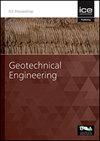新型锚索肋落石挡土墙在岩棚上的动力特性:落石冲击
IF 1.7
4区 工程技术
Q3 ENGINEERING, GEOLOGICAL
Proceedings of the Institution of Civil Engineers-Geotechnical Engineering
Pub Date : 2023-11-20
DOI:10.1680/jgeen.23.00084
引用次数: 0
摘要
采用PFC3D (discrete element method, DEM)和FLAC3D (finite element method, FEM)耦合的数值模拟方法,研究了因保护结构占用空间大而满足工程要求而设计的岩棚新型锚索肋式落石挡土墙与岩崩之间的动力行为。在模型中,对坡度的点云进行处理后,导入坡度模型。采用有限元法(FEM)通过区域单元对结构进行建模,采用离散元法(DEM)通过球单元对岩崩和缓冲层进行建模。对岩崩的动态运动进行了跟踪,得到了岩崩对结构的冲击位置和冲击速度。数值计算结果表明,模拟了岩崩运动的三个阶段,即运动、冲击和停滞。落石落在边坡上,冲击岩棚顶部缓冲层,然后反弹到锚固的落石挡土墙(高度低于2 m),将应力和挠度统一起来,并与落石冲击速度相关联,检验结构的稳定性。此外,落石半径是三个参数(落石形状、落石半径和冲击速度)中的主导参数。虽然该研究侧重于具体的案例研究,但结果为所提出的组合结构在铁路运输保护中的未来应用提供了有价值的指导。本文章由计算机程序翻译,如有差异,请以英文原文为准。
Dynamic behavior of new anchor cable ribbed rockfall retaining walls on rock shed: rockfall impact
This study investigates the dynamic behavior between a rockfall and a new anchor cable ribbed rockfall retaining walls on a rock shed, which is designed to meet project requirements due to the tremendous space occupation of the protection structure, via numerical simulations by the coupling between PFC3D (discrete element method, DEM) and FLAC3D (finite element method, FEM). In the model, the slope model was imported after the point cloud of the slope was processed. The novel structure is modeled by the finite element method (FEM) through the zone element, while the rockfall and the buffer layer are modeled by the discrete element method (DEM) through the ball element. The dynamic movement of rockfall was traced, and the impact position and velocity were obtained on the structure. The numerical results show that three stages of the rockfall movement were modeled, namely, movement, impact, and stagnation. The rockfall falls on the slope, impacting the buffer layer on the top of the rock shed, before rebounding to the anchored rockfall retaining walls (with a height lower than 2 m). Then, the stress and deflection can be unified and related to the impact velocity of rockfall to examine the stability of the structure. In addition, the rockfall radius is the dominant parameter in the three parameters (rockfall shape, rockfall radius, and impact velocity). While the study focuses on a specific case study, the results provide valuable guidelines for future applications of the proposed combined structure for railway transportation protection.
求助全文
通过发布文献求助,成功后即可免费获取论文全文。
去求助
来源期刊
CiteScore
4.40
自引率
4.50%
发文量
68
审稿时长
3 months
期刊介绍:
Geotechnical Engineering provides a forum for the publication of high quality, topical and relevant technical papers covering all aspects of geotechnical research, design, construction and performance. The journal aims to be of interest to those civil, structural or geotechnical engineering practitioners wishing to develop a greater understanding of the influence of geotechnics on the built environment.

 求助内容:
求助内容: 应助结果提醒方式:
应助结果提醒方式:


